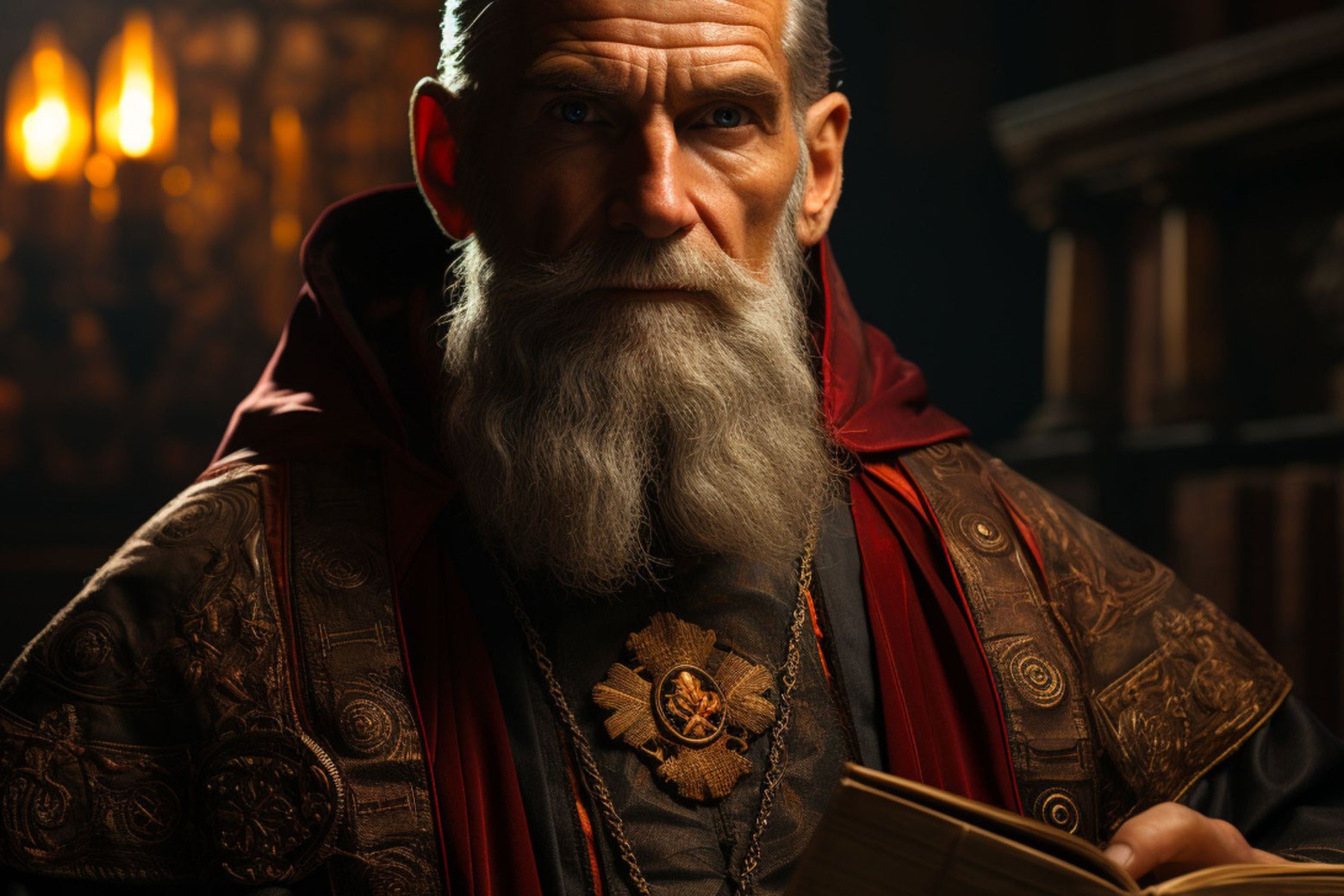Home>Theology and Spirituality>Where Did Jesus Baptism Take Place


Theology and Spirituality
Where Did Jesus Baptism Take Place
Published: February 26, 2024
Peter Smith, Editorial Director at Christian.net, combines deep insights into faith, politics, and culture to lead content creation that resonates widely. Awarded for his contributions to religious discourse, he previously headed a major organization for religious communicators, enhancing dialogue on faith's societal impacts.
Explore the significance of Jesus' baptism and its location in theology and spirituality. Uncover the historical and spiritual context of this pivotal event.
(Many of the links in this article redirect to a specific reviewed product. Your purchase of these products through affiliate links helps to generate commission for Christian.net, at no extra cost. Learn more)
Table of Contents
Introduction
Where did Jesus' baptism take place? This question has intrigued scholars, theologians, and believers for centuries. The location of Jesus' baptism holds significant religious and historical importance, as it marks the beginning of his public ministry and symbolizes spiritual purification. Exploring the historical and biblical accounts of this event can provide valuable insights into the life and teachings of Jesus Christ. In this article, we will delve into the significance of Jesus' baptism, examine the gospel accounts, and consider the location of this pivotal event based on historical and biblical evidence.
Read more: Where In The Bible Is Jesus Baptism
The Importance of Jesus' Baptism
-
Initiation of His Ministry: Jesus' baptism marked the initiation of his public ministry. It was a pivotal moment that signified the beginning of his mission to spread the message of love, compassion, and salvation.
-
Identification with Humanity: Through his baptism, Jesus identified himself with humanity, demonstrating his humility and willingness to partake in the human experience. This act of solidarity with humanity laid the foundation for his role as the compassionate savior who understands the struggles and challenges of human life.
-
Symbol of Spiritual Cleansing: Baptism symbolizes spiritual cleansing and rebirth. In the case of Jesus, it represented his sinless nature and his role as the ultimate purifier who would cleanse humanity from sin through his sacrifice.
-
Affirmation of God's Approval: The baptism of Jesus was accompanied by the voice from heaven, affirming, "This is my beloved Son, with whom I am well pleased" (Matthew 3:17). This divine affirmation validated Jesus' identity as the Son of God and affirmed the divine approval of his mission.
-
Model for Believers: Jesus' baptism serves as a model for believers, emphasizing the importance of repentance, spiritual renewal, and commitment to a life of righteousness. It sets an example for those who choose to follow his teachings and embrace the path of spiritual transformation.
-
Fulfillment of Prophecy: The baptism of Jesus fulfilled the prophecies of the Old Testament, particularly the prophecy in Isaiah 42:1, which foretold the coming of God's chosen servant who would bring justice to the nations. This fulfillment further validated Jesus' role as the promised Messiah.
-
Unity of the Trinity: The baptism of Jesus also revealed the unity of the Trinity, as the Holy Spirit descended like a dove, and the voice of the Father was heard, while Jesus stood in the water. This manifestation of the Trinity emphasized the divine nature of Jesus and the unity of the Father, Son, and Holy Spirit.
The significance of Jesus' baptism extends far beyond a mere ceremonial act. It encompasses profound theological, spiritual, and symbolic implications that continue to inspire and guide believers in their faith journey.
The Gospel Accounts of Jesus' Baptism
The gospel accounts of Jesus' baptism are found in the New Testament books of Matthew, Mark, Luke, and John. Each of these accounts provides unique perspectives on the events surrounding Jesus' baptism and offers valuable insights into the significance of this pivotal moment in his life and ministry.
Matthew's Account
Matthew's gospel describes Jesus coming to the Jordan River to be baptized by John the Baptist. As Jesus emerged from the water, the heavens opened, and he saw the Spirit of God descending like a dove and coming to rest on him. A voice from heaven then declared, "This is my beloved Son, with whom I am well pleased" (Matthew 3:13-17). This divine affirmation underscores the significance of Jesus' identity and mission as the Son of God.
Mark's Account
Mark's gospel also records the baptism of Jesus by John in the Jordan River. After Jesus was baptized, he saw the heavens being torn open, and the Spirit descending on him like a dove. The voice from heaven affirmed, "You are my beloved Son; with you I am well pleased" (Mark 1:9-11). Mark's account emphasizes the divine approval of Jesus and the manifestation of the Holy Spirit in the form of a dove.
Read more: Where Did Jesus Go After His Baptism?
Luke's Account
In Luke's gospel, the baptism of Jesus is presented as a significant event that occurred during the ministry of John the Baptist. After Jesus was baptized and was praying, the heavens were opened, and the Holy Spirit descended on him in bodily form like a dove. The voice from heaven declared, "You are my beloved Son; with you I am well pleased" (Luke 3:21-22). Luke's account highlights the role of prayer and the physical manifestation of the Holy Spirit at the moment of Jesus' baptism.
John's Account
While the Gospel of John does not provide a detailed narrative of Jesus' baptism, it does reference the event indirectly. John the Baptist testified that he saw the Spirit descend from heaven like a dove and remain on Jesus, identifying him as the Son of God (John 1:32-34). This testimony reinforces the divine nature of Jesus and his unique relationship with God.
The gospel accounts of Jesus' baptism not only establish the historical reality of this event but also emphasize its theological significance. The convergence of the divine affirmation, the descent of the Holy Spirit, and the identification of Jesus as the beloved Son collectively underscore the profound nature of this sacred moment.
The Location of Jesus' Baptism According to Historical and Biblical Evidence
The location of Jesus' baptism has been a subject of scholarly debate and historical inquiry. According to the biblical accounts, Jesus was baptized by John the Baptist in the Jordan River. The specific location within the Jordan River where this event took place has been a point of interest for historians, archaeologists, and theologians seeking to identify the precise site of this significant event.
Historical Evidence
Historical evidence regarding the location of Jesus' baptism is primarily derived from ancient texts, geographical studies, and archaeological findings. The writings of early Christian pilgrims and historians, such as Eusebius of Caesarea and the Bordeaux Pilgrim, provide valuable insights into the locations associated with Jesus' life and ministry, including his baptism.
Read more: Where Did Jesus Christ Die
Biblical Evidence
The New Testament accounts of Jesus' baptism in the Gospels of Matthew, Mark, Luke, and John consistently refer to the Jordan River as the setting for this event. The biblical descriptions of the Jordan River as a place where John the Baptist baptized multitudes and where Jesus underwent baptism provide a foundational basis for identifying the general location of this sacred act.
Traditional Sites
Several traditional sites along the Jordan River have been historically revered as the possible location of Jesus' baptism. One of the most prominent traditional sites is known as Al-Maghtas, located on the eastern bank of the Jordan River in modern-day Jordan. This site has been recognized by Christian pilgrims and scholars as the traditional location of Jesus' baptism, with archaeological evidence supporting its historical and religious significance.
Archaeological Discoveries
Archaeological excavations and studies conducted at sites along the Jordan River have yielded compelling evidence supporting the historical and biblical accounts of Jesus' baptism. Discoveries such as ancient churches, baptismal pools, and artifacts dating to the early Christian period have contributed to the identification and authentication of specific locations as potential sites of Jesus' baptism.
Theological Significance
The location of Jesus' baptism holds profound theological significance for Christians worldwide. It represents the initiation of Jesus' public ministry, the divine affirmation of his identity as the Son of God, and the symbolic act of spiritual cleansing and rebirth. The historical and biblical evidence supporting the authenticity of the location further reinforces the sacredness of this site and its enduring impact on Christian faith and devotion.
The convergence of historical, biblical, and archaeological evidence provides a compelling framework for understanding the location of Jesus' baptism. While the precise location may continue to be a matter of scholarly inquiry, the collective evidence affirms the historical reality and spiritual significance of this pivotal event in the life of Jesus Christ.
Read more: Where Did John The Baptist Baptize Jesus?
The Significance of the Jordan River in Jesus' Baptism
The Jordan River holds profound significance in the context of Jesus' baptism, serving as a symbolic and spiritually charged setting for this pivotal event in Christian theology. The river's historical, geographical, and religious importance contributes to the rich tapestry of meaning associated with Jesus' baptism in its waters.
Symbolism of Purification and Renewal
The Jordan River has long been associated with the themes of purification and renewal in the Judeo-Christian tradition. In the Old Testament, the crossing of the Jordan River by the Israelites symbolized their transition from the wilderness into the Promised Land, signifying a new beginning and a renewed covenant with God. Similarly, the act of baptism in the Jordan River represents a spiritual crossing into a new life, marked by purification from sin and a commitment to living in accordance with God's will.
Connection to Old Testament History
The historical and cultural significance of the Jordan River as a sacred waterway is deeply rooted in the narratives of the Old Testament. It was at the Jordan River that the prophet Elijah parted the waters, allowing him and Elisha to cross on dry ground (2 Kings 2:8). This miraculous event underscored the river's association with divine intervention and the manifestation of God's power. The baptism of Jesus in the Jordan River thus evokes the imagery of divine presence and the continuity of God's redemptive work throughout history.
Continuity of Prophetic Tradition
The Jordan River was also closely linked to the ministry of John the Baptist, who preached a message of repentance and prepared the way for the coming of the Messiah. His choice of the Jordan River as the site for baptizing and calling people to turn from their sins to embrace a renewed life in God reflects the prophetic tradition of using water as a symbol of spiritual cleansing and preparation for the fulfillment of God's promises. Jesus' decision to be baptized in the same river aligns with this prophetic tradition, affirming his role as the fulfillment of the Messianic hope and the embodiment of God's redemptive plan.
Spiritual Rebirth and Transformation
The act of baptism in the Jordan River represents a profound spiritual rebirth and transformation for believers. Just as the Israelites' crossing of the Jordan marked a transition into a new phase of their covenant relationship with God, baptism in the Jordan symbolizes a transition into a renewed and transformed life in Christ. The flowing waters of the Jordan serve as a powerful metaphor for the cleansing of sin and the emergence of a new identity rooted in faith and discipleship.
Contemporary Pilgrimage and Devotion
The Jordan River continues to be a site of pilgrimage and spiritual significance for Christians around the world. Pilgrims visit the river to participate in baptismal rites, seeking to connect with the sacred history and spiritual symbolism associated with Jesus' baptism. The tangible presence of the Jordan River serves as a tangible link to the biblical narrative, allowing believers to engage in a deeply personal and communal expression of faith and devotion.
In summary, the Jordan River's significance in Jesus' baptism extends beyond its role as a mere geographical location. It embodies layers of symbolism, historical resonance, and spiritual depth that enrich the understanding of Jesus' baptism as a transformative and redemptive event in Christian faith. The enduring legacy of the Jordan River as a sacred conduit for spiritual renewal continues to inspire believers to embrace the transformative power of baptism and the enduring promise of God's redemptive grace.
Conclusion
The location of Jesus' baptism, whether at the traditional site of Al-Maghtas or another location along the Jordan River, holds profound significance for Christians worldwide. The convergence of historical, biblical, and archaeological evidence provides a compelling framework for understanding the authenticity and spiritual impact of this pivotal event. Jesus' baptism marked the initiation of his public ministry, affirmed his identity as the beloved Son of God, and symbolized spiritual purification and renewal. The Jordan River, with its rich symbolism of purification, connection to Old Testament history, and continuity of prophetic tradition, serves as a powerful backdrop for the transformative act of baptism. As believers reflect on the location of Jesus' baptism, they are reminded of the enduring promise of spiritual rebirth, the continuity of God's redemptive work, and the invitation to embrace a renewed life in Christ. The location of Jesus' baptism stands as a tangible reminder of the sacred history and spiritual depth that continue to inspire faith, devotion, and pilgrimage among Christians today.











